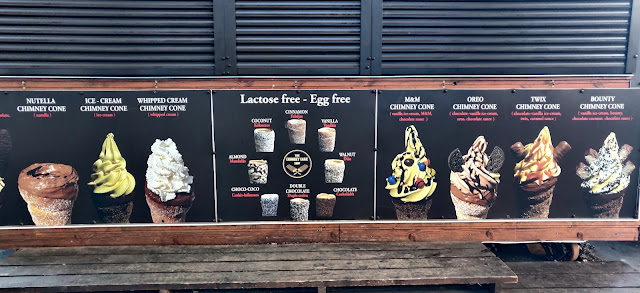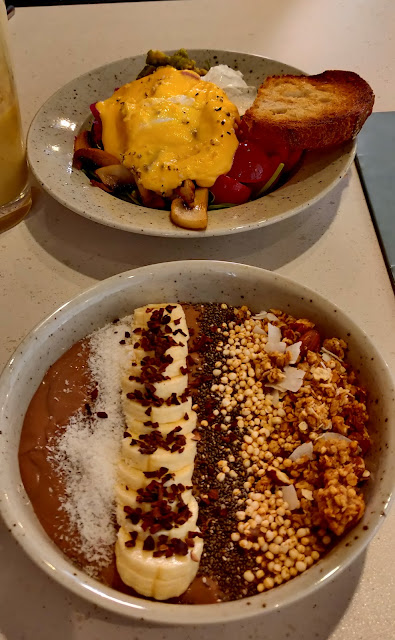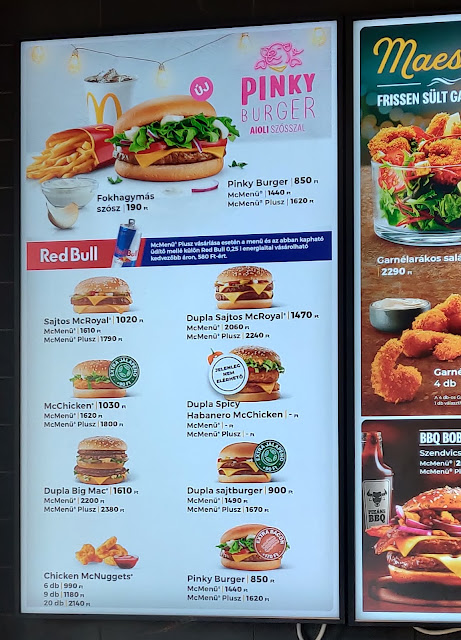If you've never taken a food tour, it's a great way to see a new city and get the inside scoop from a local on what to eat, what the locals eat and some of the history along the way. They are usually a walking tour with many small bites spread over several hours. If you are ever in Budapest, perhaps as a stopover on a Danube river cruise, I highly recommend taking one. In Budapest we took an organized food tour by Nora at http://www.foodtourbudapest.com/ She guided us through the town on a culinary adventure and gave us so much history along the way. Some of the food from these photos are from that tour, others are food we found along the way on our own.
On the food tour we learned that meats and breads were the primary foods of breakfast and supper, with a bigger meal served mid-day. We tried to follow this pattern.
More samples from the food tour. Below is the variety of salami sausages we tried at the Central Market,
Foreground: Sztrapacska with sheep cheese, bacon, sour cream,
| Background: Lecsó with eggs and sausage |
We learned that when you hear "paprika", you can't assume it is that typical smokey-sweet dried and ground pepper flavor that we're all used to. Sometimes the word is used to describe a pepper sauce (hot-sauce) that is stirred into the goulash soup or on other foods.
There are a few very nice pastry shops in Budapest. Our tour guide took us to one of the more famous shops called Hisztéria Cremeria. These are a few of the beautiful pastries on display. One of the girls behind the counter was so camera friendly she had to make sure she showed me the love.
Left: Mézes krémes (Classic Honey Creme cake)
| Right: NImród cake, 2021 winner of the "Cake of Hungary" competition |
Pastries we sampled included the traditional Hungarian honey cream cake "Mézes krémes" and the Nimrod Cake that won the national Hungarian competition for 2021. Above is just a single page from a 20 page menu book for the Cafe Frei. This place is the fastest growing coffee shop in Europe, which started in Budapest. There are so many varieties of regional coffee drinks, it makes Starbucks look old-school. They also sell their own chocolates and pastries too!
Another popular item in Budapest are the "Chimney Cakes". These are a type of pastry dough that is rolled onto a small cone shaped holder then roasted on a spit. Many vendors of these can be found on the streets or in local markets. Typically they are flavored with nuts or cinnamon, but some of the more touristy places have added fillings and toppings like ice cream or chocolate.
 |
| Tourist variations of the Chimney Cakes. |
The apple pie slices below were a totally unexpected surprise. We stopped at the café inside the museum of fine art and I ordered a slice of something familiar. Now this is a cafeteria-style eatery inside the museum. They have a captive audience, so expectations were rather low. I've eaten a lot of apple pie in my days, but this was far and away the MOST delicious apple pie I've ever had! I don't know if was the variety of apple used, or what ever else they added, but I was in heaven.
One place not on our formal tour, but we discovered ourselves is a small alleyway in the Jewish quarter, near the ruin bars that is filled with food trucks (below).
One of the trucks in this corridor was a place that served Langos Burgers. They offered many varieties including lamb and duck (about $8.00), but we opted for the traditional beef with sweet potato fries.
Lunch at the Hummus Bar, a restaurant chain throughout Europe.  |
| Foreground: Hummus Bowl with falafel and vegetables. Background: Spiced, roasted cauliflower. |
Foreground - Cashew Bowl with banana, coconut cream, cashew butter, almond butter, dates, cacao, granola, cacao nibs, puffed quinoa, shredded coconut & chia seeds.
Background- Morning Bowl with roasted mushrooms, avocado, goat cheese, poached egg, hollandaise sauce, pickled red onion, baby spinach, cherry tomatoes, hemp seeds and sourdough bread.
 |
| Cruffins and Croissants from à table! Madách Bistro. |
On our last day, we found a great Indian restaurant called Bombay. As you can see the food was delicious and nicely presented.
 |
Left: "MALAI BROCCOLI", broccoli, cheese, cashew, yogurt served with tomato chutney
Right: Tandoori Chicken on spiced sweet potato puree |
 |
| Lamb biryani and garlic naan from |
Below are some of the hand-made chocolates from a tiny little chocolate shop.
The picture below shows some of the sweets from a vendor at the street market. These colorful "licorice" vines remind me of some of the street vendors you might see in Stockholm.
French baking has a strong following in Budapest. Below is a photo of some of the macarons available at a local street vendor.
Reading labels at the grocery store is hard unless you read Hungarian. The next photo is the label of some local cheese we found at the grocery - still not sure what it was but it did have dried tomatoes and basil (paradicsom & bazsalikom).
Next is an example of the prices at a local McDonalds (1,000 huf is about $2.50).
Finally the hairy red pig was a photo our tour guide showed us to describe the type of rare pork we were having at one of the restaurants. This rare breed of pigs bred in Hungary has a very tasty meat and was made nearly extinct under Soviet occupation. |
| Hungarian mangalitsa (pig) |



























































